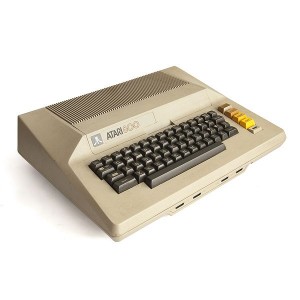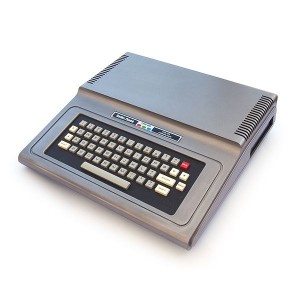When I first started writing the historical narrative that’s ended up consuming this blog, I should probably have stated clearly that I was writing about the history of computer games, not videogames or game consoles. The terms “computer game” and “videogame” have little or no separation today, but in the late 1970s and early 1980s the two were regarded as very distinct things. In Zap!, his history of Atari written just as that company was imploding in 1983, Scott Cohen takes the division as a given. He states, “Perhaps Atari’s most significant contribution is that it paved the way for the personal computer.” In predicting the future of the two categories, he is right about one and spectacularly wrong about the other. The PC, he says, will continue up a steadily inclining growth curve, becoming more and more an expected household fixture as the years go by. The game console, however, will be dismissed in future years as a “fad,” the early 1980s version of the Hula Hoop.
If we trace back far enough we can inevitably find some common origins, but the PC and game console were generally products of different folks with very different technical orientations and goals. Occasional collisions like Steve Jobs’s brief sojourn with Atari were more the exception than the rule. Certainly the scales of the two industries were completely out of proportion with one another. We’ve met plenty of folks on this blog who built businesses and careers and, yes, made lots of money from the first wave of PCs. Yet everything I’ve discussed is a drop in the bucket compared to the Atari-dominated videogame industry. A few figures should make this clear.
Apple, the star of the young PC industry, grew at an enviable rate in its early years. For example, sales more than doubled from 1979 to 1980, from 35,000 units to 78,000. Yet the Atari VCS console also doubled its sales over the same period: from 1 million in 1979 to 2 million in 1980. By the time the Apple II in 1983 crossed the magical threshold of 1 million total units sold, the VCS was knocking at the door of 20 million. Even the Intellivision, Mattel’s distant-second-place competitor to the VCS, sold 200,000 units in 1980 alone. In mid-1982, the height of the videogame craze, games consoles could already be found in an estimated 17% of U.S. households. Market penetration like that would be years in coming to the PC world.
In software the story is similar. In 1980, a PC publisher with a hit game might dream of moving 15,000 units. Atari at that time already had two cartridges, Space Invaders and Asteroids, that had sold over 1 million copies. Activision, an upstart VCS-game-maker formed by disgruntled Atari programmers, debuted in 1980 with sales of $67 million on its $25 game cartridges. By way of comparison, Apple managed sales of $200 million on its $1500 (or more) computer systems. The VCS version of Pac-Man, the big hit of 1981, sold over 2 million copies that year alone. Again, it would be a decade or more before PC publishers would begin to see numbers like that for their biggest titles.
So, we have two very different worlds here, that of the mass-market, inexpensive game consoles and that of the PC, the latter of which remained the province of the most affluent, technology-savvy consumers only. But then a new category began to emerge, to slot itself right in the middle of this divide: the “home computer.” The first company to dip a toe into these waters was Atari itself.
Steve Jobs during his brief association with Atari brought a proposal for what would become the Apple II to Atari’s then-head Nolan Bushnell. With Atari already heavily committed to both arcade machines and the project that would become the VCS, Bushnell declined. (Bushnell did, however, get Jobs a meeting with potential investor Don Valentine, who in turn connected him with Mike Markkula. Markkula became the third employee at Apple, put up most of the cash the company used to get started in earnest, and played a key role in early marketing efforts. Many regard him as the unsung hero of Apple’s unlikely rise.) Only later on, after the success of the Apple II and TRS-80 proved the PC a viable bet, did Atari begin to develop a full-fledged computer of its own.
The Atari 400 and 800, released in late 1979, were odd ducks in comparison to other microcomputers. The internals were largely the work of three brilliant engineers, Steven Mayer, Joe Decuir, and Jay Miner, all of whom had also worked on the Atari VCS. Their design was unprecedented. Although they had at their heart the same MOS 6502 found in the Atari VCS and the Apple II, the 400 and 800 were built around a set of semi-intelligent custom chips that relieved the CPU of many of its housekeeping burdens to increase its overall processing potential considerably. These chips also brought graphics capabilities that were nothing short of stunning. Up to 128 colors could be displayed at resolutions of up to 352 X 240 pixels, and the machines also included sprites, small graphics blocks that could be overlaid over the background and moved quickly about; think of the ghosts in Pac-Man for a classic example. By comparison, the Apple II’s hi-res mode, 280 X 160 pixels with 6 possible colors, no sprites, and the color-transition limitations that result in all that ugly color fringing, had represented the previous state of the art in PC graphics. In addition, the Atari machines featured four-voice sound-synthesis circuitry. Their competitors offered either no sound at all, or, as in the case of the Apple II, little more than beeps and squeaks. As an audiovisual experience, the new Atari line was almost revolutionary.
Still, externally the Apple II looked and was equipped (not to mention was priced) like a machine of serious intent. The Ataris lacked the Apple’s flexible array of expansion slots as well as Steve Wozniak’s fast and reliable floppy-disk system. They shipped with just 8 K of memory. Their BASIC implementation, one of the few not sourced from Microsoft, was slow and generally kind of crummy. The low-end model, the 400, didn’t even have a proper keyboard, just an awkward membrane setup. And it wasn’t even all a story of missing features. When you inspected the machines more closely, you found something unexpected: a console-style port for game cartridges. The machines seemed like Frankensteins, stuck somewhere between the worlds of the game console and the PC. Enter the home computer — a full-fledged computer, but one plainly more interested in playing games and doing “fun” things than “serious” work. The Atari logo on the cases, of course, also contributed to the impression that, whatever else they were, these machines weren’t quite the same thing as, say, the Apple II.
Alas, Atari screwed the pooch with the 400 and 800 pretty badly. From the beginning it priced them too high for their obvious market; the 800 was initially only slightly less expensive than the Apple II. And, caught up like the rest of the country in VCS-fever, they put little effort into promotion. Many in management hardly seemed aware that they existed at all. In spite of this, their capabilities combined with the Atari name were enough to make them modest sales successes. They also attracted considerable software support. On-Line Systems, for instance, made them their second focus of software development, behind only the Apple II, during their first year or two in business. Still, they never quite lived up to their hardware’s potential, never became the mass-market success they might (should?) have been.
The next company to make a feint toward the emerging idea of a home computer was Radio Shack, who released the TRS-80 Color Computer in 1980. (By the end of that year Radio Shack had four separate machines on the market under the TRS-80 monicker, all semi- or completely incompatible with one another. I haven’t a clue why no one could come up with another name.) Like so much else from Radio Shack, the CoCo didn’t seem to know quite what it wanted to be. Radio Shack did get the price about right for a home computer: $400. And they provided a cartridge port for instant access to games. Problem was, those games couldn’t be all that great, because the video hardware, while it did indeed allow color, wasn’t a patch on the Atari machines. Rather than spend money on such niceties, Tandy built the machine around a Motorola 6809, one of the most advanced 8-bit CPUs ever created. That attracted a small but devoted base of hardcore hackers who did things like install OS-9, the first microcomputer operating system capable of multitasking. Meanwhile the kids and families the machine was presumably meant to attract shrugged their shoulders at the unimpressive graphics and went back to their Atari VCSs. Another missed opportunity.
The company that finally hit the jackpot in the heretofore semi-mythical home-computer market was also the creator of the member of the trinity of 1977 that I’ve talked about the least: Commodore, creator of the PET. I’ll try to make up for some of that inattention next time.











